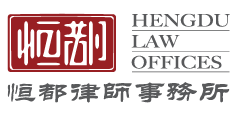Evidence that takes form on the internet is commonly called online evidence. Such information is appearing more and more frequently in patent right confirmation and infringement procedures. The main points of dispute over online evidence at the moment involve the determination of its genuineness and time of its publication.

Managing Partner
Hengdu Law Offices
In the Invalidation Petition Review Decisions No. 19214 and 20747, the Patent Re-examination Board (PRB) of the State Intellectual Property Office has come out with two different opinions on the issue of whether other evidence is necessary to corroborate the genuineness of online evidence. In a case for the confirmation of a patent entitled “lift (multi-stage cylinder type)”, the opinions of the PRB and people’s courts at two levels on the determination of the time of publication of online evidence are also completely at odds (see Invalidation Petition Review Decision No. 20983 of the PRB, and the administrative judgments First Intermediate IP Administrative No. 2702 [2013] and High Administrative No. 1221 [2014], of the First Intermediate People’s Court of Beijing Municipality and the Beijing Municipal Higher People’s Court, respectively).
Burden of proof
Whether other evidence is required to corroborate the genuineness of online evidence touches upon the issues of the allocation of the burden of proof and examination of evidence. In this regard, article 2 of the Several Decisions of the Supreme People’s Court on Evidence in Civil Procedures specifies that a party bears the burden of providing evidence supporting the facts on which its claims are based, or the facts on which its refutation of the claims of the other party are based.
If it lacks such evidence, or its evidence is insufficient to support its claim of fact, the party with the burden of proof bears the adverse consequence. The first paragraph of article 72 of the above-mentioned judicial interpretations specifies that, “if, in respect of the evidence presented by a party, the other party accepts the same or its counter evidence is insufficient to refute it, the people’s court may confirm its genuineness”.
In Invalidation Petition Review Decision No. 20747, the PRB held that “the business operator was quite liberal in revising the information on its product, and where the invalidation petitioner lacks other evidence to corroborate that the information on the webpage was not revised, the patent holder’s doubts as to its genuineness is reasonable”.
However, it is the author’s opinion that, on the one hand, such online evidence is in fact not so easily modified by the business operator, as certain preconditions are required to modify the contents of a webpage, i.e. it is necessary to secure entitlement control for the online content. Until such entitlement control is secured, even on a website on which the business operator itself maintains the product information, it is difficult for an ordinary user to modify the information on the business operator’s products over the internet.
On the other hand, in a patent right confirmation or infringement dispute procedure, the “preponderance of evidence” standard for civil procedures should be applied, rather than the “beyond a reasonable doubt” standard of criminal procedures. Based on the principles of “the party making the claim bears the burden of proof” and “preponderance of evidence”, if the patent holder claims that the content of a webpage has been modified, it should provide evidence to support the claim. If it fails to provide evidence that the petitioner modified the content of the webpage, it should bear the legal consequences of failing to meet its burden of proof.

Lawyer
Hengdu Law Offices
In the case entitled “lift (multi-stage cylinder type)”, exhibit 2 was notarised and authenticated using online evidence from Rotary’s website, its contents including a publicity pamphlet for Rotary’s VSS7 lift, with the last page carrying the words “©2005”, “Printed in USA”, and “Contact information”. The PRB recognised exhibit 2 as genuine, but held that the content on the last page was insufficient to show that the date of publication of exhibit 2 was 2005. In this regard, the First Intermediate People’s Court of Beijing Municipality and the Beijing Municipal Higher People’s Court held that, based on the information contained on the last page of exhibit 2, it could be determined that the publicity pamphlet for the product was a publication created, completed and published in 2005.
Time of publication
From this case it can be seen that time information indicated in a specific form in a specific location on online information usually can be used to indicate the time of publication of the webpage, and where there is no other more reasonable explanation for the time in question, it can be determined that such time is the time of publication of the online information.
Due to the special nature of the manner in which online evidence is manifested, notarisation is of great importance. The notarisation of online information is a form of notarisation that substantiates facts that have legal significance. This fact lies in the opening and printing of the relevant webpage in the specific circumstance of notarisation. When reviewing and determining evidence, it is necessary to verify whether it is the original document, or original thing, and its provenance. Notarisation of online information can confirm the provenance of such information, and also fulfill the function of fixing the evidence.
Integrity of information
Particular attention needs to be paid to the following matters in the course of notarisation so as to ensure the integrity and usability of the online information:
- Selection of the network terminal of a neutral third party (e.g. a notary office) as the operating equipment;
- Clearing as much as possible the hardware and software environment of the operating equipment before operation;
- Entering the target page through a useful websites list or search engine, or if directly entering the target page through its URL, keeping a detailed record of the URL entered;
- Keeping a continuous record of all of the operational steps;
- Taking a copy of the entire key page; and
- Focusing on the connection between the information on the various pages and the connection between such information and the facts to be proved.
Online information should not be treated differently because of its special form. Where the genuine provenance of online information can be established through notarisation, information should be treated in a manner equal to that of evidence in other forms.
Jiang Fengtao is the managing partner and Yang Cunji is a lawyer at Hengdu Law Offices
7th Floor, Macau Center
No.8 Wangfujing East Street
Dongcheng District, Beijing 100006, China
Tel:+86 10 5760 0588
Fax:+86 10 5760 0599
E-mail:hengdulaw@hengdulaw.com
www.hengdulaw.com






















